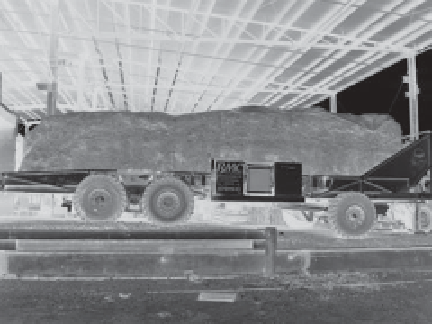Agriculture Reference
In-Depth Information
minimal and is borne totally by the contrac-
tor not the grower.
and equipment and supporting infrastructure
costs. This next section will be broken down
into three parts: (i) processing Stage 1 'classifi-
cation'; (ii) processing Stage 2 'fibre refining';
and (iii) logistics, supporting infrastructure and
costs.
The typical processing line in Europe for
Grade 2 fibre (non-woven) is a mechanical
process, braking, scutching and filtering as it
progresses. These lines need to be fully
enclosed and all dust extracted - as dust is a
health hazard - by an air pressure system with
a maximum 2 t/h capacity.
Other 6 t/h processing lines do exist
but are mostly for paper pulp grade, which
contains up to 20% hurds and is therefore
less refined and not suitable for non-woven
applications. In all EU mills, the 'classifica-
tion' component and 'fibre refining' are
incorporated into, or an extension of, 'the
one line' in the same location. This means
all the raw material has to make the journey
to the mill.
In contrast, the PW System separates
these two components for crop supply flexi-
bility, transport and cost-efficiency reasons.
The processing Stage 1 'classification' is
undertaken as close to the supply of raw
material as possible, even on the farm. This is
achieved by having a relocatable process that
can be erected and operational in 2 days.
Because the raw material is already partly
processed, the classification process simply
removes, cleans and packs ready for trans-
port approximately 50% of the raw material
(most of the hurds, dust and fines). Ideally, all
dust and fines are spread back on to the land
as a soil amendment. The hurds are packed
into shipping containers ready for direct
delivery to the market. The fibre portion is
remade into modules for transport to the sec-
ond 'fibre refining' phase in a centralized
location.
The next section deals with the classifica-
tion part only of both the European 2 t/h
system and the PW System, for ease of
comparison.
Stage 1 feed into processing system.
As the raw
material is already partly processed (Fig. 6.17a
and b), the input capacity is enhanced signifi-
cantly to between 10-20 t/h and will achieve
a consistent throughput compared to the tra-
ditional mill feeding system where feed rate
varies. Also, as the primary process has been
achieved, the amount of equipment (capital)
and power required to drive it is reduced by
approximately 50%, compared to traditional
bale opening and hammer milling.
Table 6.2 shows in AU$ the traditional
system as compared to the PW System from
those points above.
Lower cost of Stage 1 'classification'
of raw materials
Again, it will be necessary to compare the two
different methods to appreciate the efficiencies
(a)
(b)
PROCESSING STAGE
1 '
CLASSIFICATION
'
Conventional processing Stage 1 'classi-
fication'.
These systems all rely on bales of
hemp hurds. The first stage is to cut and then
Fig. 6.17a and b.
Processing the raw material in
the PW System.


